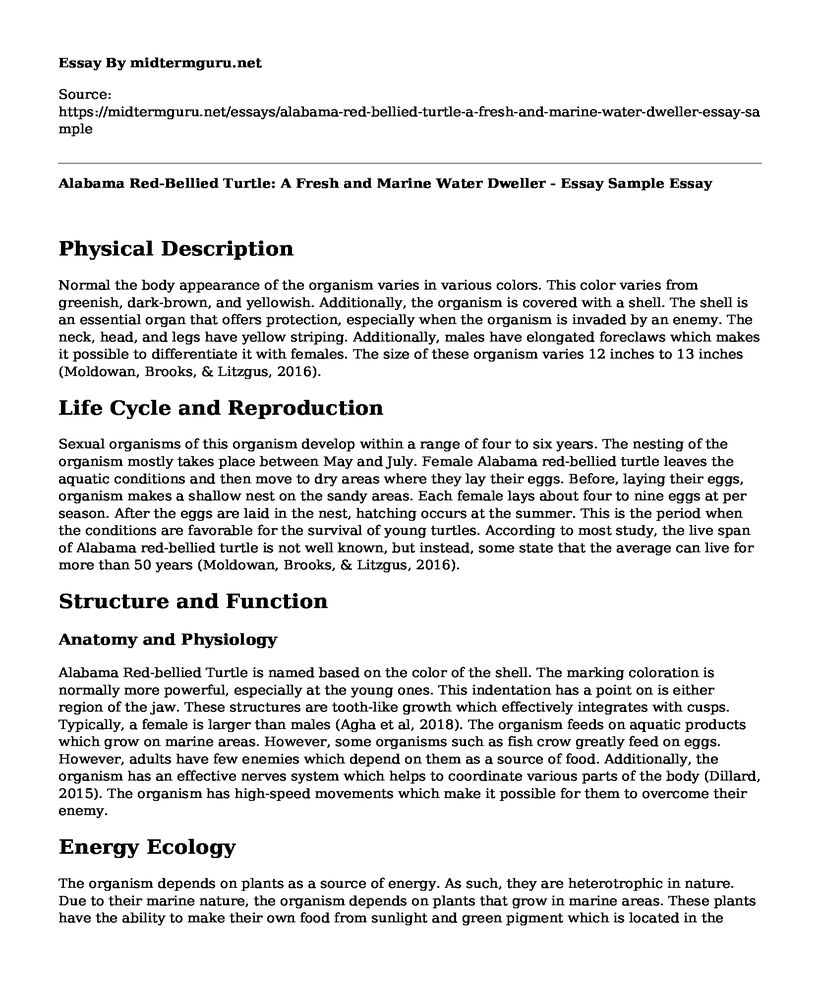Physical Description
Normal the body appearance of the organism varies in various colors. This color varies from greenish, dark-brown, and yellowish. Additionally, the organism is covered with a shell. The shell is an essential organ that offers protection, especially when the organism is invaded by an enemy. The neck, head, and legs have yellow striping. Additionally, males have elongated foreclaws which makes it possible to differentiate it with females. The size of these organism varies 12 inches to 13 inches (Moldowan, Brooks, & Litzgus, 2016).
Life Cycle and Reproduction
Sexual organisms of this organism develop within a range of four to six years. The nesting of the organism mostly takes place between May and July. Female Alabama red-bellied turtle leaves the aquatic conditions and then move to dry areas where they lay their eggs. Before, laying their eggs, organism makes a shallow nest on the sandy areas. Each female lays about four to nine eggs at per season. After the eggs are laid in the nest, hatching occurs at the summer. This is the period when the conditions are favorable for the survival of young turtles. According to most study, the live span of Alabama red-bellied turtle is not well known, but instead, some state that the average can live for more than 50 years (Moldowan, Brooks, & Litzgus, 2016).
Structure and Function
Anatomy and Physiology
Alabama Red-bellied Turtle is named based on the color of the shell. The marking coloration is normally more powerful, especially at the young ones. This indentation has a point on is either region of the jaw. These structures are tooth-like growth which effectively integrates with cusps. Typically, a female is larger than males (Agha et al, 2018). The organism feeds on aquatic products which grow on marine areas. However, some organisms such as fish crow greatly feed on eggs. However, adults have few enemies which depend on them as a source of food. Additionally, the organism has an effective nerves system which helps to coordinate various parts of the body (Dillard, 2015). The organism has high-speed movements which make it possible for them to overcome their enemy.
Energy Ecology
The organism depends on plants as a source of energy. As such, they are heterotrophic in nature. Due to their marine nature, the organism depends on plants that grow in marine areas. These plants have the ability to make their own food from sunlight and green pigment which is located in the leaves. This energy preserved by the plants is utilized by Alabama Red-bellied Turtle to provide energy which is used to maintain other body functions. Additionally, the organism has the ability to chew so as to mix feed products with saliva where digestion starts. Saliva contains some essential enzymes which play a vital role in the breakdown of food products.
Habitat
The organism lives in marine and freshwater areas. Due to the ability to swim, the organism is able to effectively move from one place to other places in search of food. Additionally, the organism has an effective breathing technique which makes it possible for them to live for many a long time. Additionally, the organism has the ability to survive in a dry land. As such, when the conditions are not effective Alabama Red-bellied Turtle moves from one region to another (Carr, 2018).
The organism is a cold-blooded, and thus, their bodies do not have the ability to regulate their temperature. As such, Alabama Red-bellied Turtle uses the environment to regulate body temperature. During winter, the organism is not so active, and hence, other activities such as movement are limited (Moldowan, Brooks, & Litzgus, 2016).
Conclusion
In summary, Alabama Red-bellied Turtle is a critical organism that has the ability to survive in various environment. The organism varies in various colors. This difference tries to differentiate various groups of the organism. Additionally, the organism has the ability to produce about four to six eggs.
References
Agha, M., Ennen, J. R., Bower, D. S., Nowakowski, A. J., Sweat, S. C., & Todd, B. D. (2018). Salinity tolerances and use of saline environments by freshwater turtles: implications of sea level rise. Biological Reviews, 93(3), 1634-1648.
Carr, A. (2018). Handbook of turtles: the turtles of the United States, Canada, and Baja California. Cornell University Press.
Dillard, K. C. (2017). A comparative analysis of geometric morphometrics across two Pseudemys turtle species in east central Virginia.
Guyer, C., Bailey, M. A., & Mount, R. H. (2015). Turtles of Alabama (Vol. 5). University of Alabama Press.
Moldowan, P. D., Brooks, R. J., & Litzgus, J. D. (2016). Turtles with "teeth": beak morphology of Testudines with a focus on the tomiodonts of Painted Turtles (Chrysemys spp.). Zoomorphology, 135(1), 121-135.
Cite this page
Alabama Red-Bellied Turtle: A Fresh and Marine Water Dweller - Essay Sample. (2023, Jan 09). Retrieved from https://midtermguru.com/essays/alabama-red-bellied-turtle-a-fresh-and-marine-water-dweller-essay-sample
If you are the original author of this essay and no longer wish to have it published on the midtermguru.com website, please click below to request its removal:
- Overview of the EEG Signal Processing Technique
- Essay on Reproductive Techniques and Technologies: Cohen and Mcmahan
- Paper Example on Hazard Controls and Solutions
- Research Paper on Microbiology
- Structural Factors Contributing to Environmental Injustices - Essay Sample
- Paper Example on Bio-Cultural Diversity
- Canada: Protecting the Environment in an Industrialized Nation - Research Paper







